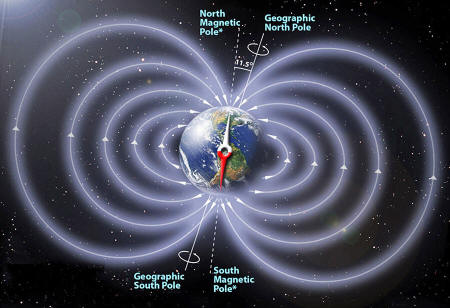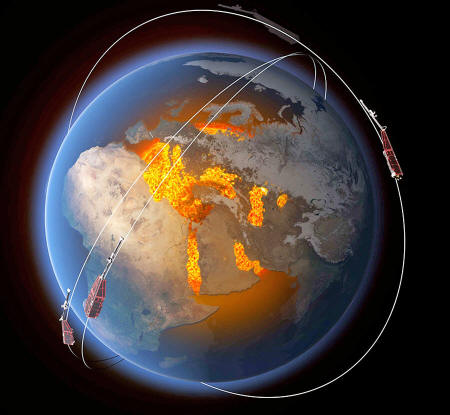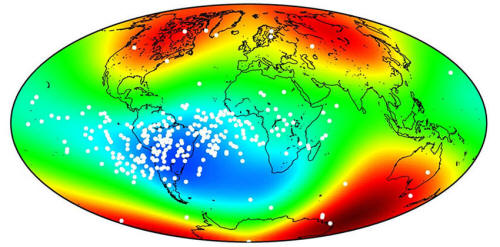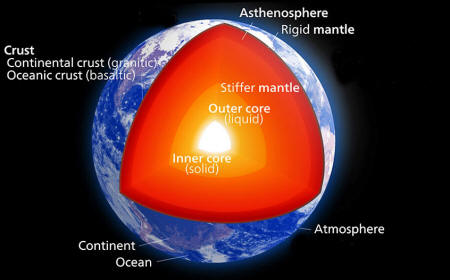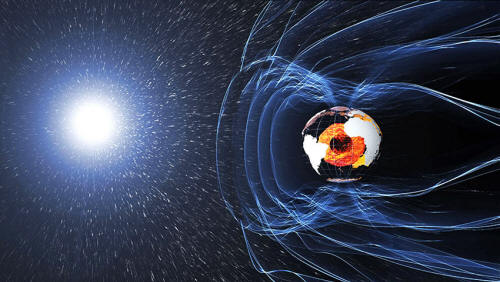|
by Bob King
from
UniverseToday Website
The magnetic field and electric currents in and around Earth generate complex forces that have immeasurable impact on every day life. The field can be thought of as a huge bubble, protecting us from cosmic radiation and charged particles that bombard Earth in solar winds. It's shaped by winds of particles blowing from the sun called the solar wind, the reason it's flattened on the "sun-side" and swept out into a long tail on the opposite side of the Earth.
Credit: ESA/ATG medialab
Although invisible to the eye, Earth's magnetic field plays a huge role in both keeping us safe from the ever-present solar and cosmic winds while making possible the opportunity to witness incredible displays of the northern lights.
Like a giant bar magnet, if you could sprinkle iron filings around the entire Earth, the particles would align to reveal the nested arcs of our magnetic domain. The same field makes your compass needle align north to south.
We can picture our magnetic domain as a huge bubble, protecting us from cosmic radiation and electrically charged atomic particles that bombard Earth in solar winds. Satellites and instruments on the ground keep a constant watch over this bubble of magnetic energy surrounding our planet.
For good reason: it's always changing.
The European Space Agency's Swarm satellite trio, launched at the end of 2013, has been busy measuring and untangling the different magnetic signals from Earth's core, mantle, crust, oceans, ionosphere (upper atmosphere where the aurora occurs) and magnetosphere, the name given to the region of space dominated by Earth's magnetic field.
At this week's Living Planet Symposium in Prague, Czech Republic, new results from the constellation of Swarm satellites show where our protective field is weakening and strengthening, and how fast these changes are taking place.
Between 1999 and May 2016 the changes are obvious. In the image above, blue depicts where the field is weak and red shows regions where it is strong.
As well as recent data from the Swarm constellation, information from the CHAMP and Ørsted satellites were also used to create the map.
The region where the field is at its weakest - the South Atlantic Anomaly - has moved steadily westward and weakened further by about 2%. Moreover, the magnetic north pole is also on the move east, towards Asia.
Unlike the north and south geographic poles, the magnetic poles wander in an erratic way, obeying the movement of sloshing liquid iron and nickel in Earth's outer core.
More on that in a minute.
The anomaly is a region over above South America, about 125-186 miles (200 - 300 kilometers) off the coast of Brazil, and extending over much of South America, where the inner Van Allen radiation belt dips just 125-500 miles (200 - 800 kilometers) above the Earth's surface.
Satellites passing through the anomaly experience extra-strong doses of radiation from fast-moving, charged particles.
The magnetic field is thought to be produced largely by an ocean of molten, swirling liquid iron that makes up our planet's outer core, 1,860 miles (3000 kilometers) under our feet.
As the fluid churns inside the rotating Earth, it acts like a bicycle dynamo or steam turbine.
Flowing material within the outer core generates electrical currents and a continuously changing electromagnetic field. It's thought that changes in our planet's magnetic field are related to the speed and direction of the flow of liquid iron and nickel in the outer core.
Chris Finlay, senior scientist at DTU Space in Denmark, said,
Further results are expected to yield a better understanding as why the field is weakening in some places, and globally.
We know that over millions of years, magnetic poles can actually flip with north becoming south and south north. It's possible that the current speed up in the weakening of the global field might mean it's ready to flip.
Although there's no evidence previous flips affected life in a negative way, one thing's for sure.
If you wake up one morning and find your compass needle points south instead of north, it's happened.
|



